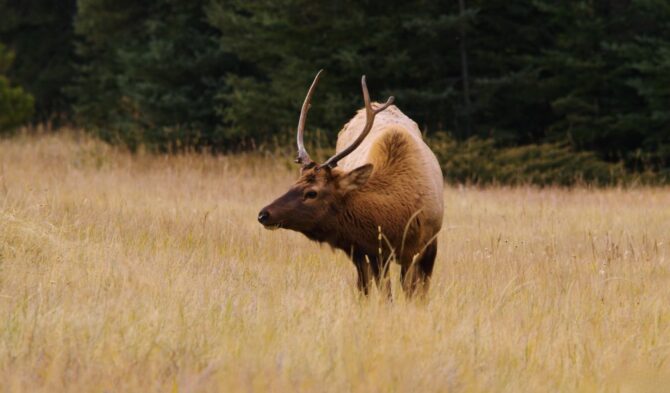Arizona, a state in the southwest of the United States, is famous for the magnificent Grand Canyon, a mile-deep chasm carved out by the Colorado River.
The southeast of this state, which has some of the best birding locations in the world, boasts a variety of magnificent landscapes and is a haven for birdlife.
While some owls migrate from far south and aren’t year-round residents, others make Arizona their home all year round.
There are currently 13 species of owls in Arizona, including the burrowing owl, barn owl, great horned owl, western screech owl, elf owl, and ferruginous pygmy owl, among others.
Owls are nocturnal birds that are characterized by excellent night vision, hearing, and stealth. Although they generally have nocturnal habits, some species are most active during the day (it all depends on the season.)
Keep reading to learn about these species found in the state of Arizona, their taxonomy, physical features, call, habitat, notable behaviors, and more.
The Species of Owls in Arizona
1. Burrowing Owl
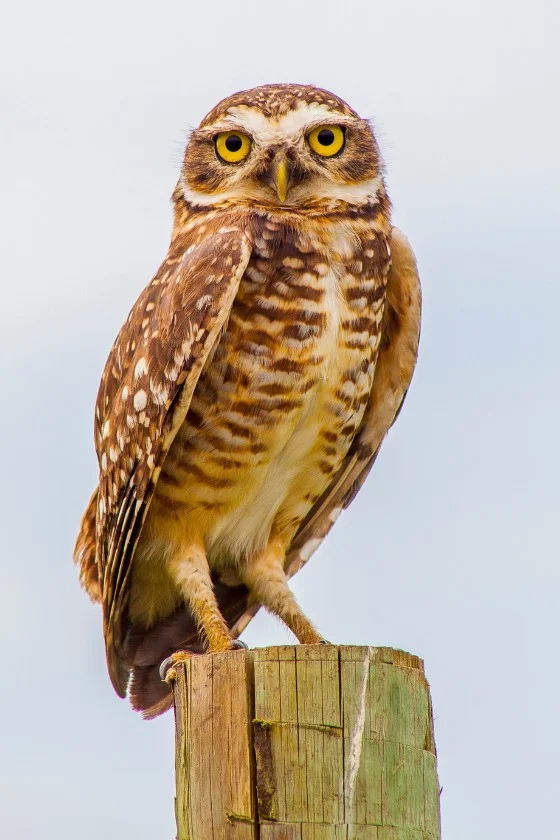
- Scientific name: Athene cunicularia
- Length: 7 – 10 inches (17.8 – 25.4 cm)
- Weight: 140 – 240 g (0.3 – 0.5 lbs)
- Wingspan: 20 – 24 inches (50.8 – 61 cm)
The burrowing owl, also known as the shoco, is a tiny, sandy-colored, and long-legged owl that inhabits open areas.
It is one of the smallest owl species and a ground-dwelling bird. It is well known for bobbing its head up and down when happy or sad.1
Burrowing owls are diurnal birds with crepuscular hunting habits. They got their name from their peculiar nesting habits.
They prefer to stay underground in burrows which they dig by themselves. However, they can also live in a prairie dog or ground squirrel’s abandoned burrow.
These unusual owls are easily identified by their ground-dwelling behavior. They are also quite distinguishable because of their long legs, round, tuft-less head, white eyebrows, and bright yellow eyes.
There are many burrowing owls distributed in southern Arizona. They can be seen living in open, arid environments with sparse vegetation, such as rangelands, deserts, prairies, and agricultural areas.
These owls have a nine-year lifespan in the wild and an additional year in captivity.
The burrowing owl is not particularly vocal, despite having roughly seventeen different calls, including cooing, chirping, rasping, clucking, screeching, and rattling sounds.
Their primary call is a quiet, two-note “who who” sound typically made at the entrance to the burrow. Males use this dominant call to entice females to the burrow and to defend their territory.
The burrowing owl stands out among all other owls in a significant way – It is a social bird, in contrast to other owls, which prefer to live alone.
In loose groups of up to several hundred individuals, this little owl coexists with members of its species. It might also coexist with other animal species.
2. Great Horned Owl
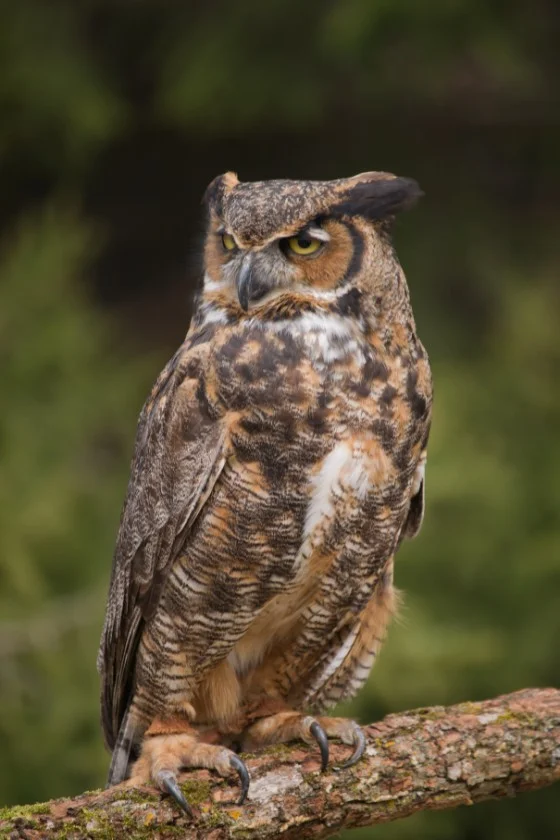
- Scientific name: Bubo virginianus
- Length: 18.1 – 24.8 inches (46 – 63 cm)
- Weight: 910 – 2500 g (2.0 – 5.5 lbs)
- Wingspan: 39.8 – 57.1 inches (101 – 145 cm)
The great horned owl is a thick-bodied, round-faced bird with strong, solid legs, feet, and claws. The distinctive horn-like feather tufts on this owl’s head are what people most often notice about them.
Its large, cat-like eyes contrast with its brown, white, gray, and black markings, which resemble tree bark. Its markings aid in hiding it in the forest.
The wings have wide, rounded tips. The white patch on its throat also serves to identify this bird—regional variations in its overall color range from sooty to pale.
The largest owl found in Arizona is the great horned owl, many of which are there. They have been observed up to 9,800 feet above sea level and have a vast habitat range.2
This owl can live and thrive in nearly any habitat thanks to its adaptability and wide prey base, including tree hollows, mountainous areas, canyons, the edges of forests, along cliff ledges, inside boulders, and caves.
They may also build their nests on the ground, in man-made structures, or even in mammal caves and dens. In the wild, this owl can live up to 28 years, and in captivity, it can live even longer.
Numerous vocalizations made by great horned owls sound strange and menacing. At night, the great horned owl’s “hoo-hoo-hoo” call can be heard in the woods. They use this low, deep hoot to announce their territories.
Because of their shrewd hunting abilities and capacity to take down a variety of prey, including some that are larger or heavier than themselves, great horned owls are known as “the tiger of the sky.”
It is easier for them to sneak up on their prey because their loosely packed feathers make them almost silent when they fly.
3. Barn Owl
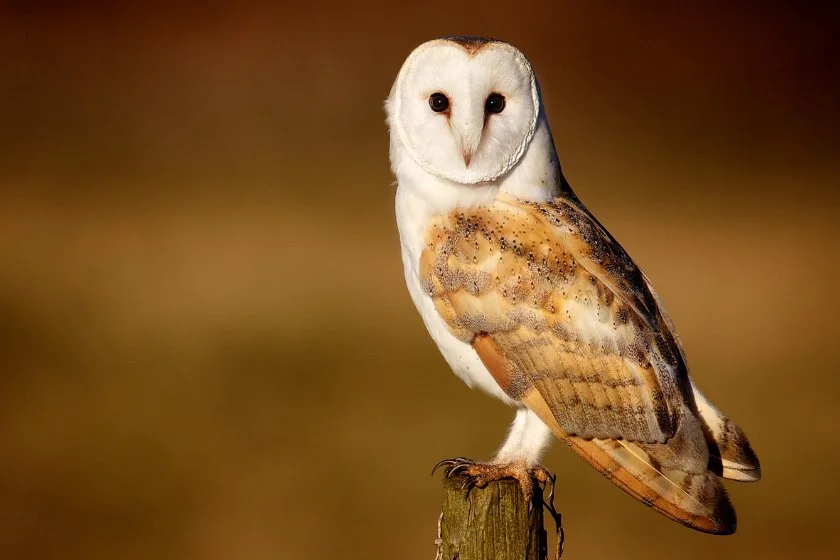
- Scientific name: Tyto alba
- Length: 12.6 – 15.8 inches (32 – 40 cm)
- Weight: 400 – 700 g (0.9 – 1.5 lbs)
- Wingspan: 99.1 – 114.3 cm ( 39 – 45 inches)
The barn owl is one of the most widely distributed bird species in the world and the most widespread owl species overall.
It is a medium-sized bird with long, rounded wings and a short tail. It has long legs and a smooth, rounded head without ear tufts.
Barn owls are generally pale and have dark eyes. They may appear completely white at night when viewed. When viewed in the air, the barn owl can be distinguished from other owl species by the shape of its tail.
The undulating flight pattern and the dangling, feathered legs are additional distinguishing characteristics. The flying bird has a distinctive appearance due to its heart-shaped pale face and dark eyes.
All over Arizona, open areas are home to barn owls. They prefer agricultural environments with spinneys, ditches, unimproved pastures, and carefully maintained field margins.
Hunting is best done in grasslands and hay meadows. They frequently roost in structures (such as barns), tree cavities, cliff crevices, or riverbanks.
Although they have been known to live up to 34 years, their average lifespan is only two to four years.
The barn owl does not hoot like some common owls, despite what many people think. Instead, it makes a distinctive piercing shriek that is ear-shattering up close and a creepy, drawn-out shriek typically made by males during courtship.
Young and old barn owls can hiss like snakes to frighten potential predators.
Barn owls are nocturnal birds with excellent hearing and night vision, enabling them to find rodents and other small mammals in total darkness.
These owls are a favorite among farmers because of their superior mouse-hunting skills.
4. Western Screech Owl
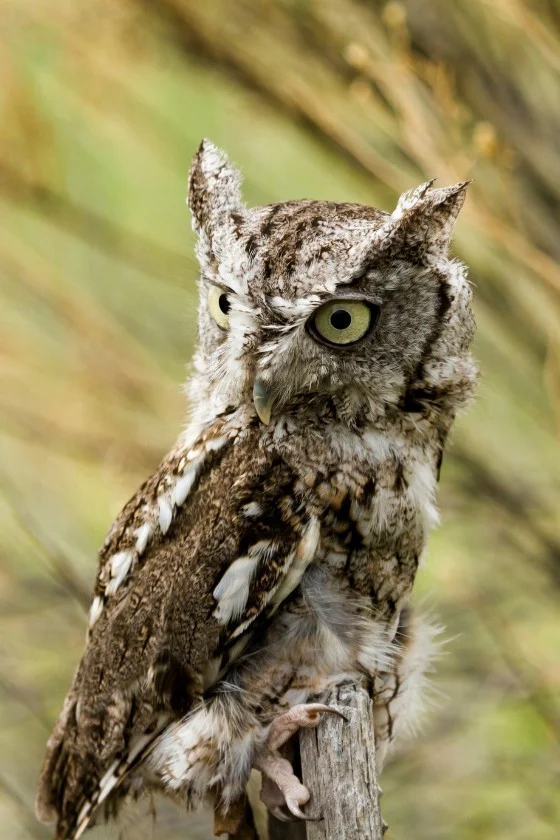
- Scientific name: Megascops kennicottii
- Length: 7.5 – 9.8 inches (19 – 25 cm)
- Weight: 100 – 305 g (0.22 – 0.67 lbs)
- Wingspan: 21.6 – 24.4 in (55 – 62 cm)
The western screech is a small, nocturnal woodland owl with feathered toes, a large head, bright yellow eyes, a white beak, and two short, pointed ear-tufts on top of its head that appear to be ears.
It is a small-streaked owl with a cryptic pattern of black and white. Their mysterious coloring, which is referred to as a “tree branch mimic,” acts as a form of organic camouflage.
Red or gray coloring are the two possible shades for these screech owls. Phases are the names given to these various coloring patterns.
Western screech owls are non-migratory birds found in wooded habitats but prefer riparian and deciduous areas. Their life expectancy in captivity can reach 19 years.
In the wild, they could live for one to thirteen years. However, very few live to that age due to high mortality rates in juveniles and adults.
This owl’s name belies its lack of screeching. It makes a series of trilling calls (short whistled notes that get faster at the end).
Males make soft trills (such as “hoo-hoo”) that indicate territorialism, especially during mating and nesting seasons, and a “secondary” call that has rapid bursts.
When greeting, they also emit a protracted “cr-r-oo-oo-oo-oo,” and when excited, they bark sharply.
The screech owl has a superb vision in both light and darkness. It can turn its head 270 degrees to look in any direction even though its eyes cannot move inside its head.3
This helps it catch prey even when it is hidden by thick vegetation or snow. The screech owl also has keen hearing, but it is less specialized than a barn owl’s.
5. Elf Owl
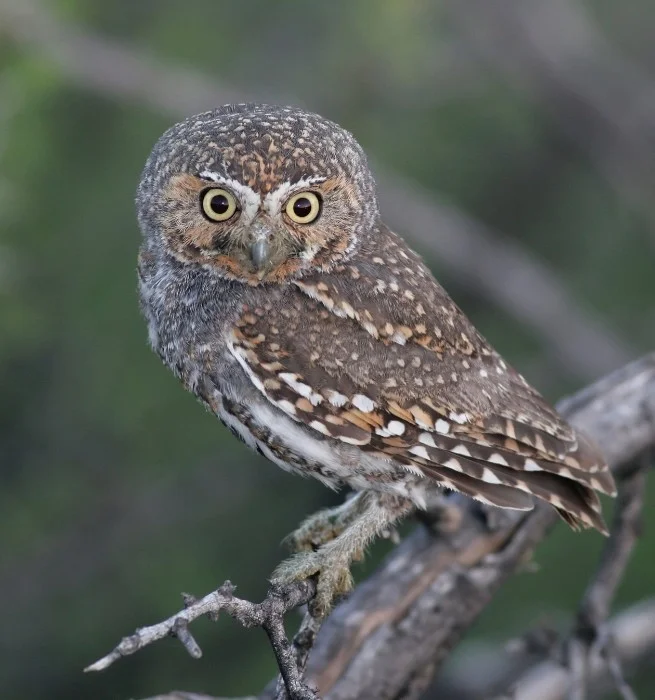
- Scientific name: Micrathene whitneyi
- Length: 4.9 to 5.7 inches (12.5 – 14.5 cm)
- Weight: 35 – 55 g (0.077 – 0.121 lbs)
- Wingspan: 13.0 inches (33 cm)
The Elf owl, also known as Whitney’s owl, is the world’s smallest and lightest owl. It is a diminutive grayish-brown bird with fairly long legs that frequently appear bow-legged, with pale yellow eyes framed by thin white “eyebrows” and a gray bill with a horn-colored tip.4
Its feathers are grayish brown and lack ear tufts or feathers on the top of its rounded head. The brown coat of this adorable and intelligent owl makes it easy to blend in.
You can find elf owls in Southeast Arizona, where they typically nest in mature saguaros and sycamores and pine and oak forests.
They have a 3-6 year lifespan in the wild and can typically live between 6 and 10 years in captivity.
Elf owls make a variety of distinctive vocalizations. To assist the male in finding his partner, the female lets out a brief “peeu” note.
When the male leaves a cavity that he has been “showing” to his mate, he can make a brief “CHU-ur-ur-ur” flight song. Both sexes emit a sharp “cheeur” frequently repeated when upset.
This tiny owl will pretend to be dead when captured until all danger has passed. This adaptation makes a predator loosen its hold, allowing the owl to flee. They are infamous for being territorial.
While they cannot see in complete darkness, they can see quite well in low light. They also have keen hearing, allowing them to locate their prey without using their eyes in total darkness.
6. Ferruginous Pygmy Owl
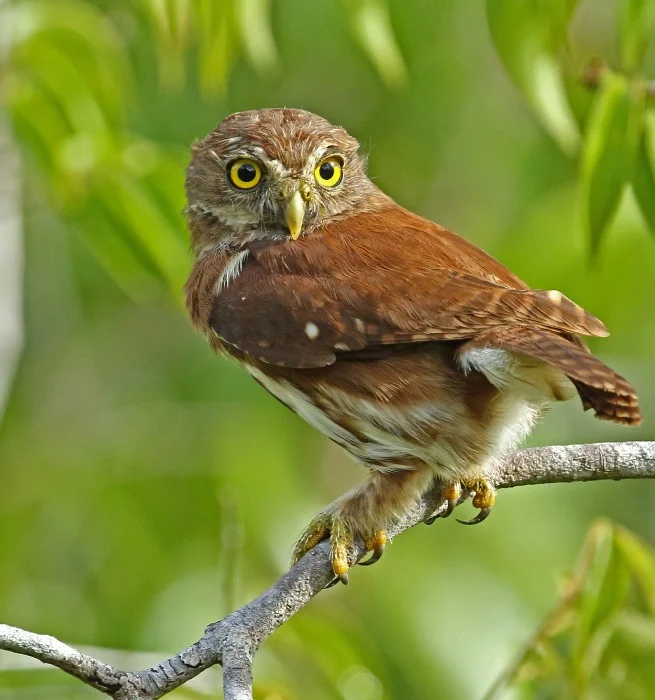
- Scientific name: Glaucidium brasilianum
- Length: 5.91 – 7.87 inches (15 – 20 cm)
- Weight: 46 – 107 g (0.10 – 0.24 lbs)
- Wingspan: 14.5 – 16 inches (37 – 41 cm)
The ferruginous pygmy owl is a small, stocky owl that breeds in south-central Arizona. It has disproportionately large feet and talons.
It is one of the most numerous owl species in Central and South America and the most widely dispersed pygmy owl.
The ferruginous pygmy owl’s overall coloring varies greatly and can be anything from rich rufous with a uniform rufous tail to grey-brown with a black-and-white barred tail.
On the back of its head is a distinctive pair of dark patches surrounded by white. These “ocelli,” or dark spots, resemble eyes.
They are believed to aid in deflecting attacks from predators like Cooper’s or Harris’s hawks as well as mobbing by flocks of smaller birds that harass them.
A variety of semi-open wooded habitats, including tropical and subtropical forests, forest edges, riverine forests, dry oak woodlands, bushy areas, the saguaro desert, and mesquite, are home to this pygmy owl. They live for roughly 6 to 7 years.
Although they call throughout the day, ferruginous pygmy owls are most vocal at sunrise and sunset.
A staccato string of hollow-sounding whistles serves as their primary call. Birdwatchers frequently use this call to draw in smaller birds because it is simple to imitate.
Although nocturnal, this owl species frequently hunts during the day. Their flight frequently moves in an undulating pattern, like many woodpecker species.
7. Flammulated Owl
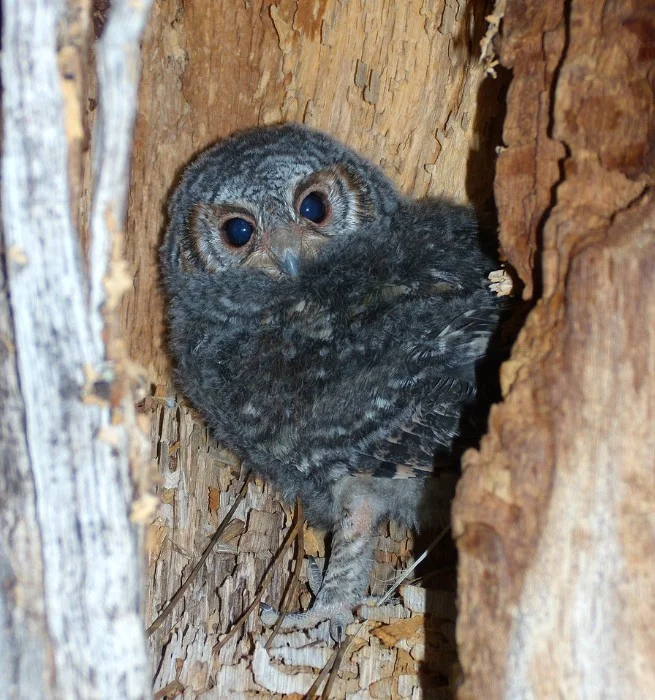
- Scientific name: Psiloscops flammeolus
- Length: 5.9 – 6.7 inches (15 – 17 cm)
- Weight: 43 – 63 g (0.09 – 0.14 lbs)
- Wingspan: 15.9 – 16.1 inches (40.5 – 41 cm)
The flammulated owl is a small, nocturnal, reddish owl with wings that, despite being large for its body, it can use to fly quickly between trees.
It is the sole species designated to the genus Psiloscops and is a migratory North American owl belonging to the Strigidae family.
This tiny owl gets its name from the flame-like markings on its face and wings. Greyer variations don’t have this feature, though.
Its mix of dark brown, gray, buff and white feathers offers the ideal camouflage. It has small, tuftless ears that are frequently held flat against the head and big, dark eyes.
Mature mountain forests are home to flammulated owls. They can live up to 8 years and typically build their nests in tree holes that other birds, like woodpeckers or flickers, once used.
They can make various sounds, such as twittery noises, screams, and mews. Their primary call is fairly deep with a ventriloquial effect that they repeat regularly every two to three seconds.
One or two ‘grace’ notes, or preliminary, lower-pitched notes, are frequently heard before the call. This owl will make notes resembling a kitten’s meowing when it is alarmed.
8. Northern Saw-Whet Owl
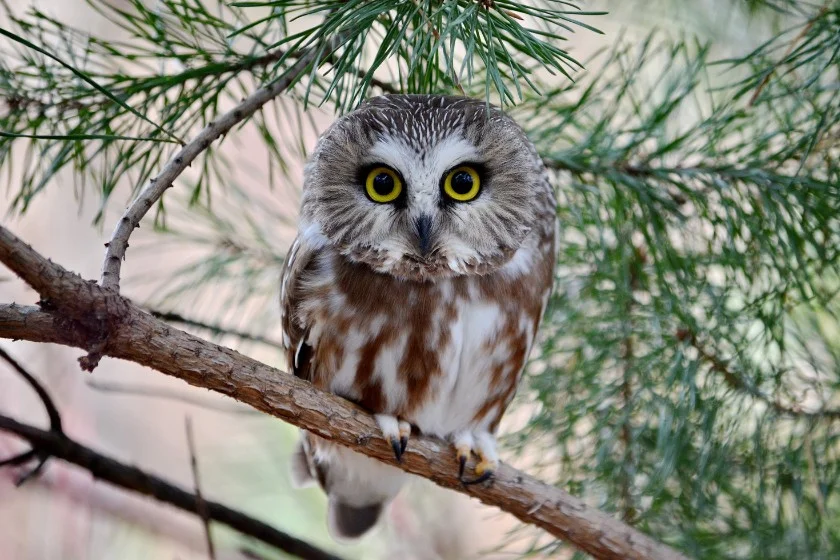
- Scientific name: Aegolius acadicus
- Length: 7.1 – 8.3 inches (18 – 21 cm)
- Weight: 65 – 151 g (0.14 – 0.33 lbs)
- Wingspan: 16.5 – 18.9 inches (42 – 48 cm)
The Northern saw-whet owl is one of the state’s tiniest and cutest. It has a small body and a broad, rounded head. Its plumage is a deep brown color with fine white spots on its upper parts and streaks of white on its underparts.
Its facial disc is paler brown and has a white Y-shape that runs from the brows to the bill between its large yellow eyes.
Coniferous forests are the primary habitat of northern saw-whet owls. They roost during the day in dense vegetation, usually close to the trunk of evergreen trees and just above eye level.
They also move to mixed or deciduous woodlands in the winter. They build their nests in tree holes made by woodpeckers or abandoned bird nests. In the wild, they can live up to 7 years, and in captivity, 16 years.
The nocturnal northern saw-whet owls have keen hearing and can locate prey solely by sound. They have a loud, piercing call that is audible from a distance.
Saw-whets also produce whines, guttural sounds, high tssst calls, squeaks, and high-pitched barks, and have a whistle, repetitive toot that sounds like a saw being sharpened on a whetting stone.
9. Long-Eared Owl

- Scientific name: Asio otus
- Length: 13.8 – 15.8 inches (35 – 40 cm)
- Weight: 220 – 435 g (0.5 – 0.96 lbs)
- Wingspan: 35.4 – 39.4 inches (90 – 100 cm)
Long-eared owls are lanky with long ear tufts that typically point straight up like exclamation points, giving them the appearance of being surprised.
Their distinctive ear tufts earned them the “long-eared” name. These owls have a mixture of buff, grey, and brown in their dark, patterned plumage.
Dark brown streaks can be seen on the buff underparts. The center of its buff facial disc is white. Its bill is greyish-black, and its eyes are orange-yellow.
The long-eared owl can be found throughout the state. It can be found breeding in Arizona. These owls live in wooded areas, and forests close to open spaces with a lot of vegetation, like grasslands and shrublands.
In addition, you can find them in gardens, parks, cemeteries, orchards, and farms. They have adapted to semi-desert environments in Arizona and other southwestern states, where they nest, roost in oases and hunt across the dry, open landscape. A 13-year maximum life span has been recorded.
Due to its camouflage, this nocturnal, shy, and elusive owl is difficult to spot. It produces a wide variety of sounds that differ by region.
The male sings in a loud, whooping voice. Females whistle nasally and at a high pitch. Additionally, they yell in a cat-like manner. Despite having excellent camouflage, they often roost in groups and are silent during the winter.
10. Northern Pygmy Owl
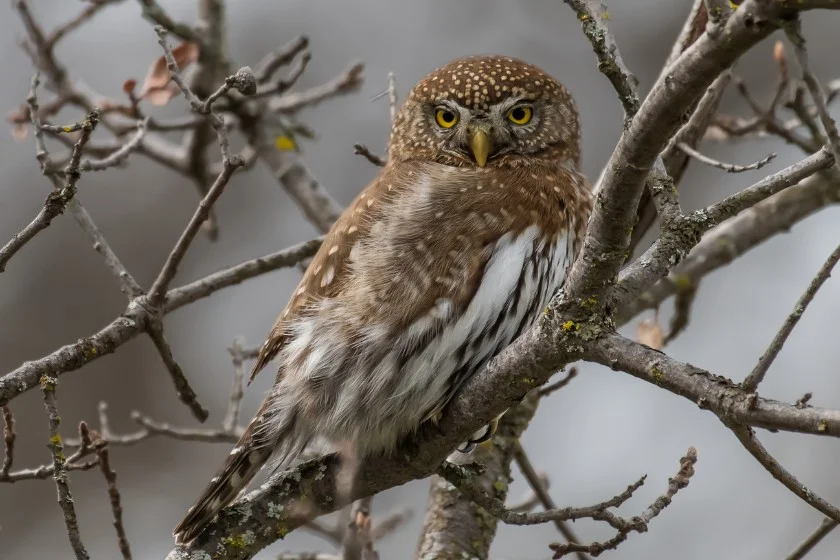
- Scientific name: Glaucidium californicum
- Length: 7 – 7.5 inches (17.8 – 19.1 cm)
- Weight: Male: 62.4g (0.14 lbs); Female: 73.7g (0.16 lbs)
- Wingspan: 14.5 – 16 inches (36.8 – 40.6 cm)
The northern pygmy is a short, plump owl with a fairly long tail and a large, round head. It has white below with dark brown streaks and brown above with white spots.
The toes of the northern pygmy’s legs are covered in feathers. It has eye spots on the back of its neck, like other pygmy owls, which may serve as a deterrent to predators approaching from behind.
North American forests and woodlands are home to northern pygmy owls. They are more visible than most owls because they are active during the day and are most common in southeast Arizona (still, they often go unnoticed.)
They build their nests in woodpecker-digged holes in trees. Despite being nocturnal, pygmy owls also hunt at dawn and dusk.
These owls have an estimated lifespan of around 7 years on average. The oldest found and released pygmy owl was 3 years and 11 months old.
A high-pitched trill is the northern pygmy’s call. Their small size, yellow beaks and eyes, and white spots on their heads serve as telltale signs of identification.
The Northern Pygmy Owl is not typically attracted to artificial nest boxes, unlike other owl species.
11. Short-Eared Owl
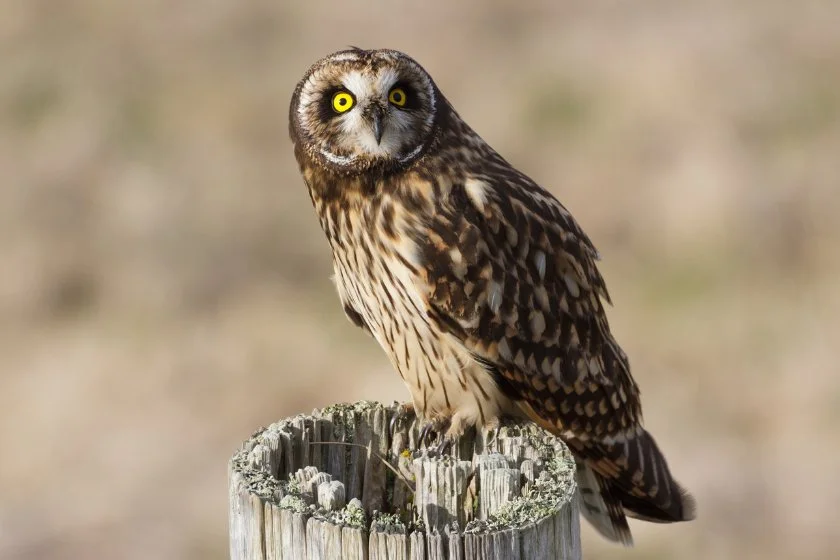
- Scientific name: Asio flammeus
- Length: 13.4 – 16.9 inches (34 – 43 cm)
- Weight: 206 – 475 g (0.45 – 1.05 lbs)
- Wingspan: 33.5 – 40.5 inches (85 – 103 cm)
The medium-sized Short-eared owl inhabits grasslands. It is named for the small ear tufts on its round head. It has buff-colored underparts and upper parts with dark streaks on the breast.
Its facial disc is brown and has a pale rim around the edge. The face is white in the center, with dark eye patches surrounding its piercing yellow eyes.
This owl is one of the most common owl species in the world, and you can frequently spot it during the day. The best time to spot them in Arizona will be during the winter since they don’t breed there.
Each year, they move northward to their breeding locations in Canada and Alaska. These owls live in broad, open spaces with little vegetation.
They build their nests on the ground, partially hidden by low vegetation. Short-eared owls construct their nests, unlike other owl species.
Due to their association with open rather than wooded habitats, they use various display postures and can rely more on these than vocalizations.
Rapid wing-clapping bursts are part of the display. Their typical call is a raspy bark, but they are largely silent in the winter. In the wild, these owls have 4 to 12 years of life.
12. Whiskered Screech Owl
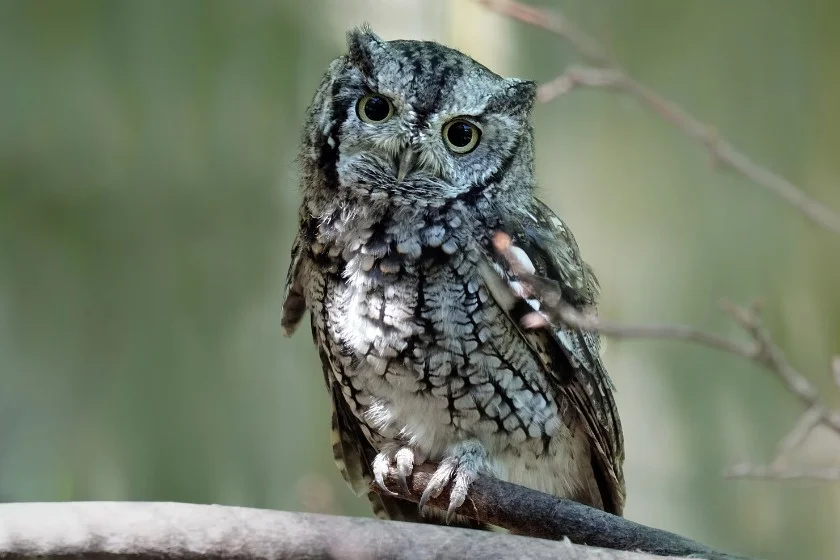
- Scientific name: Megascops trichopsis
- Length: 6.9 – 8.3 inches (17.5 – 21 cm)
- Weight: 85 – 98 g (0.19 – 0.22 lbs)
- Wingspan: 15.8 – 19.7 inches (40 – 50 cm)
The second-smallest owl in the Megascops genus is the Whiskered screech-owl. This owl resembles the western screech owl in appearance, but it is smaller and has heavier breast barring.
It has a round head, short ear tufts, yellow eyes, and a yellowish bill. The wispy bristles at the base of the beak gave rise to the name “whiskered screech owl.”
The mysterious, infrequently seen whiskered screech owl is a bird whose range is extremely constrained not just in Arizona but generally.
It hunts from dusk until dawn and builds its nest in either naturally occurring or woodpecker-made cavities in sycamore or oak trees.
This screech owl can be heard and seen frequently in Madera Canyon and other mountainous regions like the Madrean Sky Islands.
The most frequent call of the whiskered screech owl is a series of about 8 evenly spaced “boo” notes, with one note slightly higher in the middle and one slightly lower at each end.
The female has a slightly louder voice. Moth-like rapid wing beats and silence characterize flight. The lifespan of this owl species is roughly 3–7 years in the wild, though it may live longer in captivity.
13. Mexican Spotted Owl
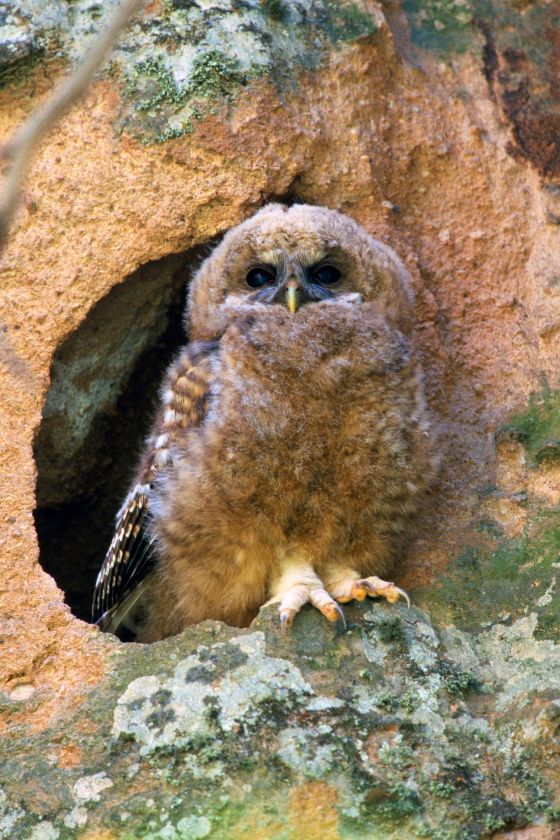
- Scientific name: Strix occidentalis lucida
- Length: 16-19 inches (41 – 48 cm)
- Weight: 547 – 647 g (1.21 – 1.43 lbs)
- Wingspan: 42-45 inches (107 – 114 cm)
One of the three subspecies of spotted owl and one of the biggest in North America is the Mexican spotted owl.
You can find it in isolated areas in the US states of Arizona, Colorado, New Mexico, Texas, Utah, and Nevada. In the wild, on average, Mexican spotted owls typically live for 15 years.
Being taller and heavier than a crow, these spotted owls are among the larger owl species. Their faces are distinctive, mostly dark brown, and they have a white X between their coal-colored eyes.
Canyonlands and forested mountains are where you can find the Mexican spotted owl. They enjoy spending time in trees and primarily go hunting at night.
When they hear their prey, these patient nocturnal stalkers quickly swoop down and seize it with their razor-sharp talons. They listen in complete silence.
Most of the spotted owl’s calls are composed of pure tones and relatively low pitch, enabling the owl to communicate over great distances through dense vegetation.
This is crucial for a nocturnally active animal roaming a sizable territory and communicating effectively with its mate and nearby owls across sizable distances.
During December through February, Mexican spotted owls are mainly silent and only vocalize from March to November.
What are some tips for successful owling?
Since most owl species are nocturnal, finding them can be challenging. Additionally, owls are solitary and elusive by nature. The following are some pointers for effective owling:
- Find out more about the owl species that inhabit the area where you’re looking.
- Learn the different owls’ calls, and pay close attention when they are calling. It’s more likely that you’ll hear them before you see them.
- Because owls have excellent camouflage and feathers designed to blend into the night, ensure you look around carefully.
- Keep an eye out for their brown or grey, elliptical, or spherical pellets. A lot of pellets suggest an owl is roosting or nesting close by.
- Avoid using loud noises or bright lights to disturb or scare them away.
Frequently Asked Questions
What is the most common owl in Arizona?
The barn owl is the most prevalent owl and one of the most common birds in Arizona.
Where can you see owls in Arizona?
The Madrean Sky islands, the Ponderosa Pine Forest, and Madera Canyon are some of Arizona’s prime bird-watching locations.
Are owls protected in Arizona?
Arizona state law (ARS Title 17) and the Migratory Bird Treaty Act (MBTA) provide federal protection for all owls found in Arizona. Whether unintentional or malicious, breaking these laws can lead to legal action.
Wrap-up
Owls are extremely valuable to humans and have high economic and ecological values.
They are particularly helpful in agricultural areas because they are possibly more effective than pesticides at controlling pests.
There are many places to see owls in Arizona, a beautiful state in the southwest with a wide variety of species.
We hope this article has been a valuable resource for understanding the various species.
References & Notes
- Burrowing owl. Smithsonian’s National Zoo.
- Smith M. 2006. Arizona’s Great Horned Owls like it where the livin’ is easy. News West Publishing.
- Screech Owl. Cosley Zoo.
- Meet the Tiniest Owl in the World. Audubon, 2007.

